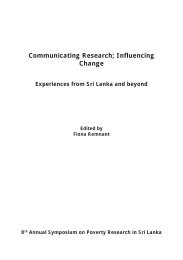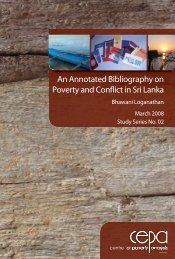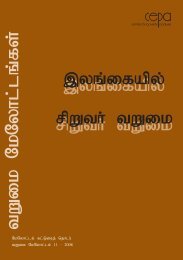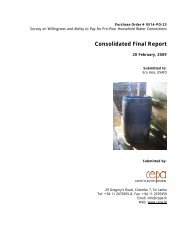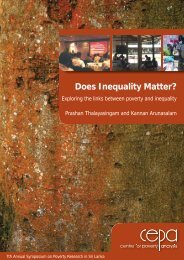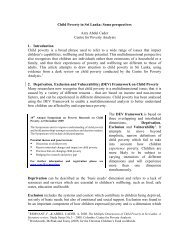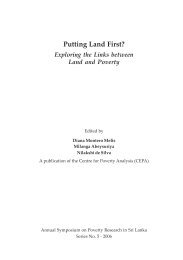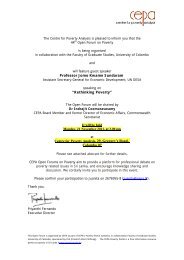Involuntary Displacement and Resettlement â Policy and ... - CEPA
Involuntary Displacement and Resettlement â Policy and ... - CEPA
Involuntary Displacement and Resettlement â Policy and ... - CEPA
- No tags were found...
You also want an ePaper? Increase the reach of your titles
YUMPU automatically turns print PDFs into web optimized ePapers that Google loves.
we feel, was instrumental in the sample having properties similar to thepopulation. We also included some IDP households currently living in <strong>and</strong>around Batticaloa town but either in rented houses or with relatives. Weinterviewed all except non-Sampur households in these locations. Note thatthe financial situation <strong>and</strong> livelihoods (as well as other facets) of the IDP lifeis in a state of constant change <strong>and</strong> that our results are correct as of April,2008 9 .5 Categories of Livelihoods in SampurIn this study of livelihoods of IDPs, we first examine case studies of fourfamilies, from four categories of livelihoods that we have developed: Type ILabour, Type II Labour, Government Servants, <strong>and</strong> Asset Holders. Type ILabour consists of families whose main income is from masonry <strong>and</strong>carpentry. What is unique about these livelihoods is that they rely mainly onlabour endowments <strong>and</strong> have a ready market in Batticaloa town. In otherwords this category of workers had a ready dem<strong>and</strong> in their hostcommunities. Though there are other skilled labour related livelihoods inSampur, families relying on Type I Labour are special as their skills continueto provide the IDPs with substantial income.Type II Labour consists also of livelihoods emanating from labourendowments. For example, families who, before displacement, relied onwork related to agriculture, fisheries, stone breaking, brick making, etc.,were included in this category. It must be highlighted that families whoselivelihoods relate to ownership of agricultural l<strong>and</strong> <strong>and</strong> fishing boats <strong>and</strong>wadis were not included in this category (See the description for AssetHolders). Type II Labour, in contrast to Type I, has experienced manychallenges in getting established in the host community. For example, thedistance between IDP camps in Batticaloa town <strong>and</strong> the nearest paddy fieldsor the sea restricts farmers <strong>and</strong> fishermen from engaging in their formerlivelihoods. The loss of networks, as well as concerns for personal security,restrict people of this category seeking jobs in distant locations. Type IIpeople seem to have responded to this situation by engaging in low payingmanual work in place of the kind of work they formerly did in Sampur. Thishas arguably reduced their economic <strong>and</strong> social status.9At the time of data collection, the subjects have been displaced for two years. Whenever thedata corresponds to the two-year period we interpolated on a straight line basis to calculate thevalue for a one-year period. The data was analysed in SPSS.65



